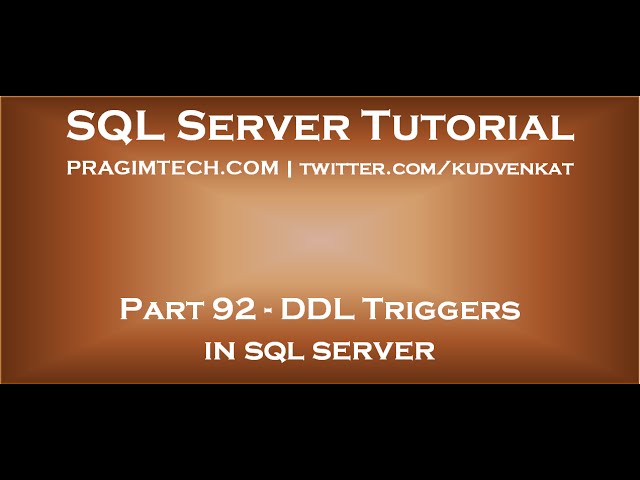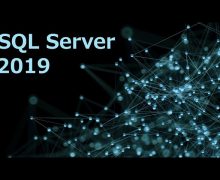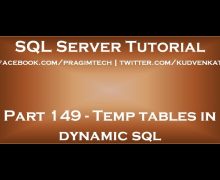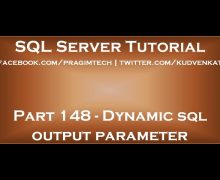
DDL Triggers in sql server

ddl trigger example
ddl trigger example in sql server
ddl triggers can be used to
In this video we will discuss DDL Triggers in sql server.
In SQL Server there are 4 types of triggers
1. DML Triggers – Data Manipulation Language. Discussed in Parts 43 to 47 of SQL Server Tutorial.
2. DDL Triggers – Data Definition Language
3. CLR triggers – Common Language Runtime
4. Logon triggers
What are DDL triggers
DDL triggers fire in response to DDL events – CREATE, ALTER, and DROP (Table, Function, Index, Stored Procedure etc…). For the list of all DDL events please visit https://msdn.microsoft.com/en-us/library/bb522542.aspx
Certain system stored procedures that perform DDL-like operations can also fire DDL triggers. Example – sp_rename system stored procedure
What is the use of DDL triggers
If you want to execute some code in response to a specific DDL event
To prevent certain changes to your database schema
Audit the changes that the users are making to the database structure
Syntax for creating DDL trigger
CREATE TRIGGER [Trigger_Name]
ON [Scope (Server|Database)]
FOR [EventType1, EventType2, EventType3, …],
AS
BEGIN
— Trigger Body
END
DDL triggers scope : DDL triggers can be created in a specific database or at the server level.
The following trigger will fire in response to CREATE_TABLE DDL event.
Use SampleDB
Go
CREATE TRIGGER trMyFirstTrigger
ON Database
FOR CREATE_TABLE
AS
BEGIN
Print ‘New table created’
END
To check if the trigger has been created
1. In the Object Explorer window, expand the SampleDB database by clicking on the plus symbol.
2. Expand Programmability folder
3. Expand Database Triggers folder
Please note : If you can’t find the trigger that you just created, make sure to refresh the Database Triggers folder.
When you execute the following code to create the table, the trigger will automatically fire and will print the message – New table created
Create Table Test (Id int)
The above trigger will be fired only for one DDL event CREATE_TABLE. If you want this trigger to be fired for multiple events, for example when you alter or drop a table, then separate the events using a comma as shown below.
ALTER TRIGGER trMyFirstTrigger
ON Database
FOR CREATE_TABLE, ALTER_TABLE, DROP_TABLE
AS
BEGIN
Print ‘A table has just been created, modified or deleted’
END
Now if you create, alter or drop a table, the trigger will fire automatically and you will get the message – A table has just been created, modified or deleted.
The 2 DDL triggers above execute some code in response to DDL events (CREATE_TABLE, ALTER_TABLE, DROP_TABLE).
Now let us look at an example of how to prevent users from creating, altering or dropping tables. To do this modify the trigger as shown below.
ALTER TRIGGER trMyFirstTrigger
ON Database
FOR CREATE_TABLE, ALTER_TABLE, DROP_TABLE
AS
BEGIN
Rollback
Print ‘You cannot create, alter or drop a table’
END
To be able to create, alter or drop a table, you either have to disable or delete the trigger.
To disable trigger
1. Right click on the trigger in object explorer and select “Disable” from the context menu
2. You can also disable the trigger using the following T-SQL command
DISABLE TRIGGER trMyFirstTrigger ON DATABASE
To enable trigger
1. Right click on the trigger in object explorer and select “Enable” from the context menu
2. You can also enable the trigger using the following T-SQL command
ENABLE TRIGGER trMyFirstTrigger ON DATABASE
To drop trigger
1. Right click on the trigger in object explorer and select “Delete” from the context menu
2. You can also drop the trigger using the following T-SQL command
DROP TRIGGER trMyFirstTrigger ON DATABASE
Certain system stored procedures that perform DDL-like operations can also fire DDL triggers. The following trigger will be fired when ever you rename a database object using sp_rename system stored procedure.
CREATE TRIGGER trRenameTable
ON DATABASE
FOR RENAME
AS
BEGIN
Print ‘You just renamed something’
END
The following code changes the name of the TestTable to NewTestTable. When this code is executed, it will fire the trigger trRenameTable
sp_rename ‘TestTable’, ‘NewTestTable’
The following code changes the name of the Id column in NewTestTable to NewId. When this code is executed, it will fire the trigger trRenameTable
sp_rename ‘NewTestTable.Id’ , ‘NewId’, ‘column’
Text version of the video
http://csharp-video-tutorials.blogspot.com/2015/09/ddl-triggers-in-sql-server.html
Slides
http://csharp-video-tutorials.blogspot.com/2015/09/ddl-triggers-in-sql-server_9.html
All SQL Server Text Articles
http://csharp-video-tutorials.blogspot.com/p/free-sql-server-video-tutorials-for.html
All SQL Server Slides
http://csharp-video-tutorials.blogspot.com/p/sql-server.html
All Dot Net and SQL Server Tutorials in English
https://www.youtube.com/user/kudvenkat/playlists?view=1&sort=dd
All Dot Net and SQL Server Tutorials in Arabic
https://www.youtube.com/c/KudvenkatArabic/playlists









![C++ Tutorial [104] – Smart Pointer: shared_ptr GERMAN](http://www.coderswebsite.com/wp-content/uploads/2016/08/c-tutorial-104-smart-pointer-sharedptr-german-youtube-thumbnail-70x70.jpg)













Social